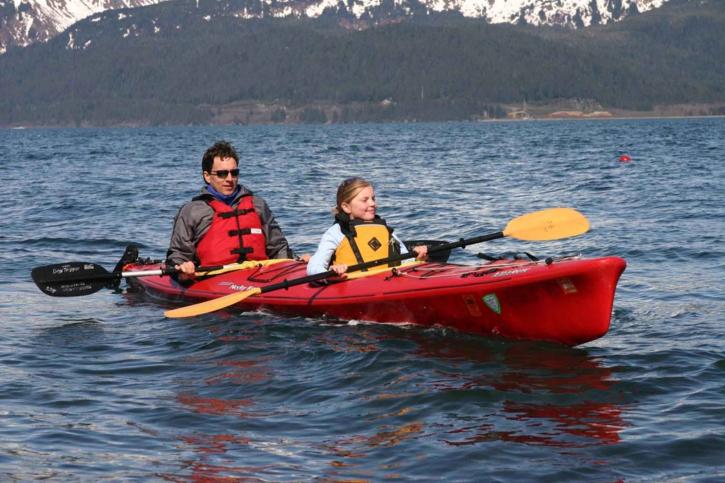Some anglers worry about fish running away, so they choose dark kayaks. But does this method work? Do bright-colored kayaks scare fish?
Fish can see colors, but it doesn’t mean they are afraid of vivid-colored objects. In fact, they try to hide from something else.
This article will help you clear this question. Let’s follow our guide and learn how to fish with truths, not myths!
Do Bright Colored Kayaks Scare Fish?
The answer is No. It doesn’t matter what color your kayak is to fish. These creatures are only scared of movement and shadows from above.
Fish vs. Colors
The color of your kayak will not much affect how successfully you can fish. So, you can pick a color that matches your personal preferences and angling style.
Usually, you cast into the cover while seated in your kayak 25 to 30 feet away from your prey. The fish won’t even pay you and your kayak much attention at that distance.
Fish vs. Movement
Motion from above and shades that are passing or close to fish will frighten them more than any particular color may.
Fish are smart, and they know that sometimes predators, like eagles and sea eagles, attack from above.
In streams and rivers, fish adhere close to the bank. They are aware that predators on the ground will swoop down from high.
It is much more important to stay stealthy by being quiet and not slamming stuff around your kayak. Please note that noises are enemies of fish.
Read more: Complete Guide to Kayak Fishing for Crappie
Which Color Should The Kayak Be?
If you prioritize safety, red and orange kayaks will be the best choices. However, green, tan, or brown can help with concealment.
For safety
Visibility is crucial for safety. Although a kayak’s color is unimportant to the fish, a bright boat will be much more noticeable to other people. Believe us, and the vivid color can help you in some cases.
First, it becomes much easier for those who are kayaking around on the water to avoid hitting you.

Fish might not be able to hear you if you’re angling and motionless, but they can see an orange kayak in the lake.
Hence, the color can help avoid crashes when visibility is limited.
Second, a bright boat will be much easier to identify from the land and the water if something bad happens and you get lost or stuck out on the water for any reason.
Choose an orange or red kayak for safety. These hues will stand out sharply against both land and water because they are uncommon in nature.
Furthermore, these kayaks are unlikely to blend with rocks, reeds, mud, or any place you might get stuck.
Do not select a yellow kayak if you routinely kayak through whitewater.
Although this color will appear vivid in a store, it can mix pretty well with the white waves and may be difficult to detect, particularly from above.
For concealment
Many kayakers feel safe in places. If you are among them, go for other solutions instead of the visibility issue.
In this situation, you might want to pick a green, brown, sandy, or tan kayak.
Any of those colors should provide you with sufficient underwater concealment, depending on the environment you paddle.
Some models come in camouflage hues, making it possible to blend in with nearly any surroundings.
Although these kayaks don’t help you sneak past fish, you can blend in with the lake and perhaps stay hidden from other creatures.
They are softer in your eyes if you spend a lot of time sitting while angling.
If you choose a muted kayak, prepare something easily visible with you to use in case of getting stuck. Those items help rescuers and other kayakers find you.
Reflective strips are a great addition to the kayak. You can cover or display them whenever you need them.

How To Avoid Scaring Fish?
Bright colors don’t scare fish. So you can use other methods to avoid frightening your prey, such as:
Cast from afar
Fishing at a reasonable distance from your fishing area is the best way to prevent startling fish when kayaking.
Avoid fishing directly beneath or around your boat. Alternatively, cast the line farther out, where the noise of the kayak won’t distract the fish.
Lower the noise
Try to be quiet and move gently through the water if you’re talking.
Reduce the noise and splashing you make because such noise will scare off all the fish in your area.
Minimize the noise you make in the cockpit as well. Be careful around lures and gear that may hit the deck.
Be careful of any possible knocking you may do on the kayak’s sides, whether it comes from the rods you’re holding or the paddle.

Mistakes When Choosing A Fishing Kayak
Kayak colors don’t matter while fishing, so what do? Here are some mistakes new kayakers often make when choosing their boats.
Get the wrong size
You must determine the width and length of your kayak because it affects how the boat stays balanced on the water.
It also changes the boat’s performance in terms of speed and maneuverability.
If you’re still learning to balance, stay away from kayaks with thin hulls.
The increased speed and effectiveness are worthless if you keep falling over every few feet.
Choose a heavy paddle.
Your fishing experience usually differs depending on your paddles. The two most common causes are:
- You have aluminum paddles with additional ounces of weight, which make you exhausted in only a few miles.
- You use fiberglass or carbon paddles. Moreover, they fit nicely in your hands. Such paddles will give you a relaxing paddling experience.
You don’t want the first situation to happen. Although the paddle weight doesn’t affect your fishing performance, it ruins your relaxation while kayaking.
Buy a touring kayak.
Long, slender paddles on touring kayaks are ideal for a relaxing stroke over hours of paddling. However, these paddles pull a lot of water.
Meanwhile, high-angle paddles on fishing kayaks are shorter and wider than those on touring paddle blades. Each stroke increases the impact they deliver.
Moreover, most kayak fishing paddles also feature a hook retrieval device built into one blade.
Each has a built-in tape measure in both centimeters and inches on the shaft.
Select a kayak without a paddle management system
When trying to land a fish, don’t just put it across the kayak, where it could easily get kicked back into the water.
Even if you put your fish on your lap, which looks safer, your paddle will drop when you stand up suddenly.
Installing a paddle management system on your fishing kayak would be advisable.
When your hands are busy with the fishing rod, fish, and net, you’ll need a safe place to keep it.
Frequently Asked Questions
Q: Do fish see colors?
Yes. Fish color vision is pretty comparable to our color vision in many situations.
Cone and rod cells in the fish retina enable them to see color and light, respectively.
Most fish can recognize color at wavelengths from UV to red. Freshwater fishes have a limited variety of characteristics depending on, for instance, whether they are shallow-water hunters or deep-water bottom feeders.
Q: Which color fishing kayak should you get?
The kayak color doesn’t affect your fishing trip. Yet, it’s important for your safety and concealment.
If you are afraid of getting stuck in the middle of the water, get vivid colors like orange or red. Otherwise, you may want concealment, and green, brown, or tan can help in this case.
Q: What is the most popular kayak color?
Yellow is the popular hue, and for a good reason—these boats look gorgeous.
Meanwhile, the best color for water visibility is orange or red, which makes it the safest option for kayakers.
Q: What color stands out most in the ocean?
According to tests, orange and green are the most apparent on the water at greater distances and under any illumination level.
Wrapping Up
Don’t worry about your bright-colored kayak because it won’t annoy the fish. It’s shadows and motions that frighten them.
To avoid scaring all the fish in your area away, try to minimize the noise you make and cast from afar. Then, enjoy kayaking and have a successful trip.
Thank you for reading!